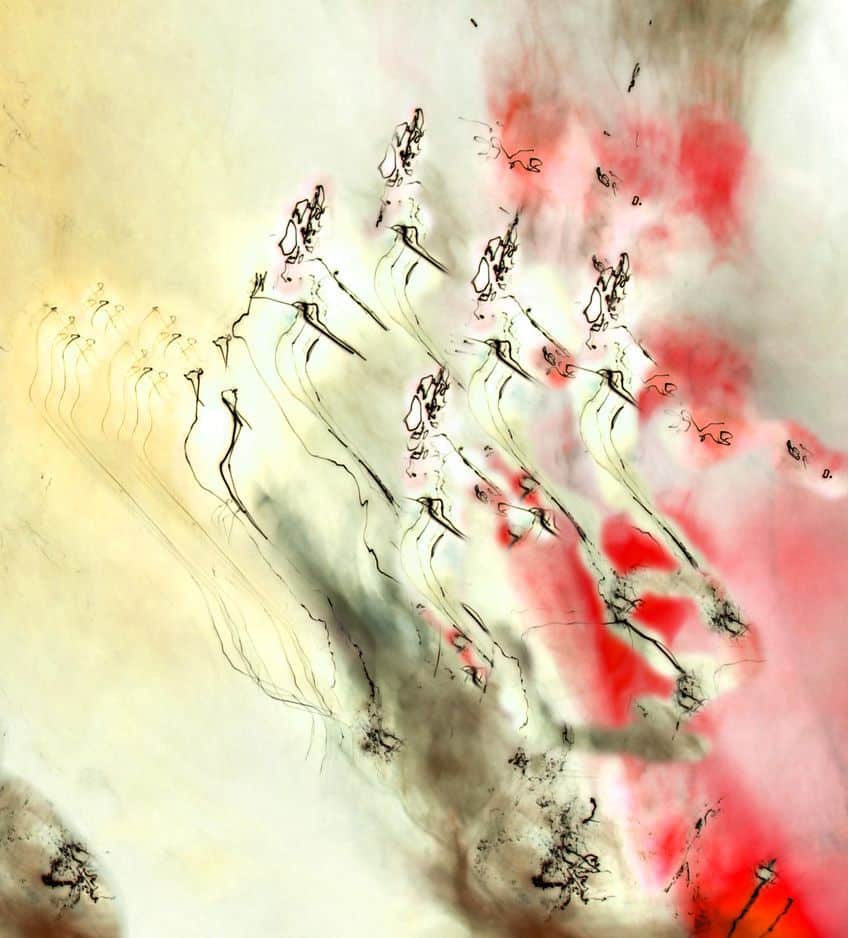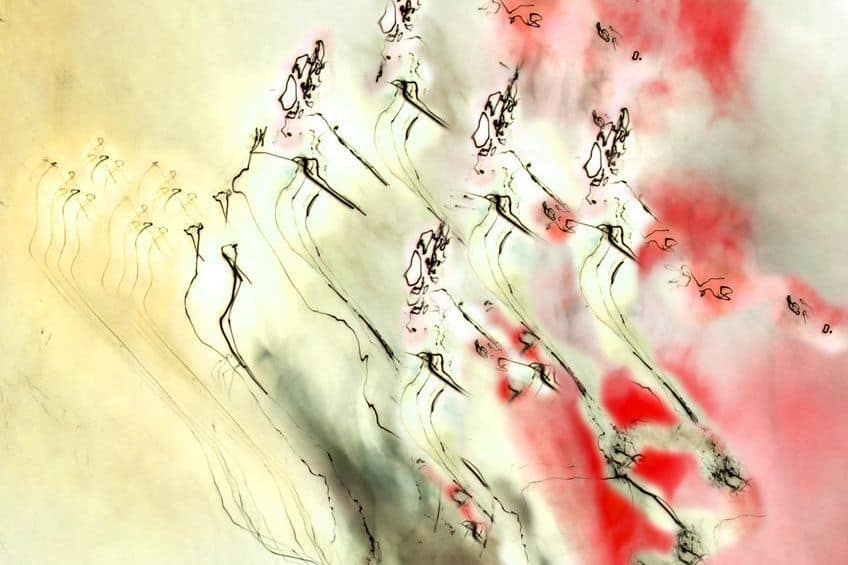What Is Automatism Art? – The Basis of Surrealism Automatism
What is Automatism art or Psychic Automatism? The concept of Surrealism Automatism first emerged when a few friends, who subsequently became known as the Surrealists, sought to unleash the possibilities of the subconscious and imagination, encouraged by Sigmund Freud’s revolutionary investigations into psychoanalysis. This article will explore the origins of Psychic Automatism and will look at a few notable Automatism artwork examples.
Contents
What Is Automatism Art?
It was a method of understanding how our minds function, how we form diverse connections, and how our unconscious changes us. And Surrealism Automatism was a means to investigate how this functioned. The Surrealists would often gather for “Waking dream” ceremonies in which they pushed each other into altered states of consciousness, and didn’t eat or sleep for days, all in order to investigate the undiscovered corners of mind and spirit. Their Psychic Automatism artworks – paintings, sketches, and texts – served as proof for these experiments.

Surrealists were opposed to their work having a slogan, a significant social message, or a historical narrative. They didn’t want a blueprint to govern their art. They thought that our reason suppressed our subconscious. As a result, they sought to resist thinking about art while creating it. Have you ever doodled while talking on the phone? This is precisely what André Masson was doing when he created his Automatic Drawings series. He pretended to be doing something else, such as chatting on the phone, listening to music, or people talking on the radio, while doodling. Finally, he stared at his sketches and waited for his mind to make the initial association.
This was his subconscious communicating with him.
The History of Surrealism Automatism
When André Breton wrote the Surrealist Manifesto in 1924, he defined the movement using the notion of complete Psychic Automatism. Surrealists claimed to operate on the basis of an unconstrained creative mentality. Surrealism was first characterized as a type of Psychic Automatism, but he subsequently reconceptualized it along the principles of a religious doctrine, as a mental mechanism or mental state that might serve as a cure for life’s issues.

The first theories on the autonomously produced workings of the psyche came from Sigmund Freud, who explored the relationship between the subconscious, visions, and the psyche. Since our thoughts are not logically constructed when dreaming, Freud saw dreams as a tool for exploring the unconscious. Our unconscious side freely expresses itself through guises and metaphors that seem to be difficult to put into words but may be portrayed in figurative depictions.
Surrealists accepted these principles, which serve as the foundation for Surrealist thought and its iconography of Surrealism Automatism.
The Early Days of Surrealism Automatism
André Breton, a Surrealism theorist, was worried that, while dreams are significant in everyone’s lives, they do not receive enough attention. The greater reality, or surreality in his terminology, can only be attained by combining a live reality with a dream. Surrealism was the vehicle used to do this, and the trend quickly drew many creatives looking for new means of expression, free of visual cliches associated with social and moral standards. Breton characterized it as: “Surrealism automatism in its pure form, by which one offers to convey, by way of the writing, or in any other sort of way, the real working of the mind. Dictated by mind, immune from artistic or moral concerns in the absence of any restraint applied by logic”. Initially, automatism was thought to be largely a textual method involving an unbroken flow of words.
Automatic writing methods began in 1919 and have continued with varying degrees of effectiveness throughout the years.
Breton himself stated that “the story of automatic writing in Surrealism is one of perpetual catastrophe”. Subsequently, Max Ernst proposed a method of addressing visual depictions through automatism focused on collage, frottage, or grattage, and the accidental effects created by these processes. Surrealists such as Rene Magritte, André Masson, Salvador Dali, and Juan Miró recognized the Manifest’s concepts and the methodology it envisaged, and began work on an exploratory journey of the subconscious mind that was significantly removed from regular daily reality, burdened with the challenging task of making sense and finding meaning after the death and destruction of World War I. According to Ernst, the artistic techniques they used were oil painting, which included the creation of Cadavre Exquis, video, photography, and sculpture.
The Strange and Deformed Combinations of Surrealism Automatism
Although the haphazard and unplanned mixing of themes and materials is obvious in Surrealist work, there are notable contrasts between the methods of automatism used and the innovative approaches this methodology created. Unplanned compositions or unexpected matching, as well as dream-like features, sometimes known as unreal deformations, can be differentiated into two categories resulting from various uses of psychic automatism. In the first, compositions are fully left to chance and spur-of-the-moment inspirations, whereas dream-like compositions are more deliberate, but retain the instinctive combination of things that frequently do not exist together in reality.

The automatist aspect was more prominent in the creations of André Masson and Joan Miró, while drawings and paintings by Max Ernst, René Magritte, and Salvador Dali flourished in dream-like worlds. Yet, these broad tendencies were not as clear-cut as they appear. Artists’ adherence to these two orientations was not as rigorous, and they frequently dabbled with both, but works from the 1920s are more associated with spontaneous compositions, while pieces from the 1930s featured dream-like approaches.
The Surrealists emphasized the concept of the revolution, which was an uprising of the subconscious against logic.
It was a revolution that liberated the domain of visions and associations from the constraints of norms and regulations. Dreams had to be brought to the forefront of our lives as well as that of society. Max Ernst created this surreal artwork while suffering from measles. A fever dream “triggered by an imitation-mahogany paneling across from his bed, the grooves of the wood adopting progressively the appearance of a bird’s head, a frightening nightingale, a rotating wheel, and so on”, he said.
Beyond Surrealism
While psychic automatism in art is most closely associated with Surrealism and its use of visions, hypnosis, and occasionally even narcotics to free the mind from its rational restrictions, it has also been used in earlier and later epochs. The first examples of automatism in art date back to the 18th century and the “blot paintings” of Alexander Cozens, who painted watercolor vistas from incidental splotches of color on paper. William Blake likewise attributed the genesis of his pictures to forces other than his intellect. Other artists, besides Surrealists, sought unrestricted expression in the 20th century, while not explicitly invoking psychological automatism.
Jackson Pollock pioneered a technique known as Action Painting, which involved flowing paint over a canvas and emphasizing the significance of process over the end product, whereas Les Automatistes, a French-Canadian group of artists, modeled their pieces on automatic writing.
Many Surrealists migrated to the United States before WWII, where they affected the local scene. Magical Realism addressed societal concerns through surreal interpretations of reality. Surrealism, one of the previous century’s most prominent cultural movements, has been thoroughly examined in terms of its contribution to literature and art. Its impact and significance in the formation of intellectual concepts, both philosophical and political, has yet to be completely explored.
Automatism Artwork Examples
Surrealism, motivated by the theories of psychologist Sigmund Freud, was an intellectual, and artistic movement that advocated a revolution against the restrictions of the logical mind and, by implication, the laws of a repressive society. Freud and others employed several strategies to bring his patients’ subconscious ideas to the surface. Many of the same methods were used to stimulate the Surrealists’ writing and art, with the assumption that imagination that originated from deep inside people’s subconscious might be more potent and true than any output of conscious thinking.

The Entire City (1934) by Max Ernst
| Artist | Max Ernst (1891 – 1976) |
| Date Completed | 1934 |
| Medium | Oil paint on paper on canvas |
| Dimensions (cm) | 50 x 61 |
| Location | Tate Collection, London, United Kingdom |
The picture portrays a metropolis made out of a slew of geometric shapes placed against a deep blue sky. The dark contours of the city’s structures are accentuated by striations and floral motifs in orange and pink tones. A little white ring in the composition’s upper left-hand corner appears to depict the moon. The lack of clarity or definition, as well as the layered, textured architecture, hint that this is a ruined metropolis. Ernst utilized grattage to achieve the random textured appearance visible in the artwork, which involves passing an item or piece of material, such as a board of wood or the spine of a fish, over the layer of paint.
In this manner, he was able to allow much of the texture to be created automatically.
Star, Winged Being, Fish (1955) by André Masson
| Artist | André Masson (1896 – 1987) |
| Date Completed | 1955 |
| Medium | Oil, sand and glue on canvas |
| Dimensions (cm) | 55 x 38 |
| Location | Tate Collection, London, United Kingdom |
On the 15th of July 1955, Masson wrote eagerly to his colleague and art collector Daniel-Henry Kahnweiler about several new sand works he had just started: “I’m splattering sandy glue over stretched canvases. I like the outcome of this investigation, of this excessive spontaneity. Whereas previously I would throw sand onto the glued surfaces, presently I put glue onto the support, with only rhythm and the fire of imagination as my reference point – it is always the same thing that I would like, that seems to be, to expose motion, flourishing, or the conception of things “. Masson created comparable sand paintings in the mid-1920s when he pioneered the art of sketching mechanically or without conscious control within the surrealist group. In the late 1930s, he produced a small number of significant sand paintings.
The Surrealists exploited automatism to allow the immediate and uncontrollable outpouring of unconscious ideas. André Breton presented a dictionary-style explanation of automatism in his first Surrealist Manifesto, thereby making automatism a synonym for Surrealism. Psychic automatism is in its purest form, a method through which one attempts to articulate, in writing, or in any other way—the real working of the mind. Constrained by thinking, free of any creative or moral concern in the dearth of any restraint exercised by logic.
Frequently Asked Questions
What Is Automatism Art?
Automatism emerged in the early 20th century as a reaction to society’s rising industrialization and automation. Dada and Surrealism were influential, as were concepts about the unconscious mind and the significance of the imagination’s creativity in artistic expression. Surrealism Automatism is an art movement that stressed the utilization of automatic mechanisms in the production of art, such as subconsciousness or randomness.
How Do Artists Create Automatism Artworks?
Artists that embraced automatism in their work frequently used techniques like automatic sketching, handwriting, and painting, in which they let their hands run freely across the paper or canvas with no preconceived assumptions of what the final outcome should look like. They felt that by going through this process, they would be able to tap into their unconscious mind and produce more intuitive and emotive pieces of art.
Jordan Anthony is a Cape Town-based film photographer, curator, and arts writer. She holds a Bachelor of Art in Fine Arts from the University of the Witwatersrand, Johannesburg, where she explored themes like healing, identity, dreams, and intuitive creation in her Contemporary art practice. Jordan has collaborated with various local art institutions, including the KZNSA Gallery in Durban, the Turbine Art Fair, and the Wits Art Museum. Her photography focuses on abstract color manipulations, portraiture, candid shots, and urban landscapes. She’s intrigued by philosophy, memory, and esotericism, drawing inspiration from Surrealism, Fluxus, and ancient civilizations, as well as childhood influences and found objects. Jordan is working for artfilemagazine since 2022 and writes blog posts about art history and photography.
Learn more about Jordan Anthony and about us.
Cite this Article
Jordan, Anthony, “What Is Automatism Art? – The Basis of Surrealism Automatism.” artfilemagazine – Your Online Art Source. February 28, 2023. URL: https://artfilemagazine.com/what-is-automatism-art/
Anthony, J. (2023, 28 February). What Is Automatism Art? – The Basis of Surrealism Automatism. artfilemagazine – Your Online Art Source. https://artfilemagazine.com/what-is-automatism-art/
Anthony, Jordan. “What Is Automatism Art? – The Basis of Surrealism Automatism.” artfilemagazine – Your Online Art Source, February 28, 2023. https://artfilemagazine.com/what-is-automatism-art/.



